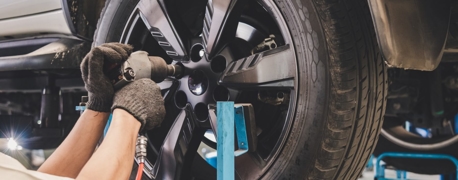Booking a Rideshare? Here’s What You Should Know About Accidents, Insurance & More

Sharing rides is not by any means a new concept. It can be traced all the way back to World War I when the U.S. government required ridesharing to conserve rubber for the war. People continued to voluntarily share rides in the following decades, but it wasn’t until 2010 that a new way to rideshare became widely available.
With the capabilities of smartphones and their popularity, new rideshare companies offered a way for people to schedule and pay for rides from their phones in real time. Uber, Lyft (then known as Zimride), and Sidecar were the first to offer ridesharing in this way. These companies matched drivers with passengers, essentially working as a platform for drivers who wished to operate as a taxi and get paid to take one or more people from point A to point B.
Today, Uber and Lyft dominate the rideshare market in the United States. Ridesharing has increased exponentially in popularity and ease of use; the worldwide ridesharing market is estimated at $85.8 billion. As of 2022, about 36% of Americans have used a ridesharing app.
Ridesharing has brought an unmatched level of convenience to traveling by automobile. It eliminates the need for a designated driver because you can summon one at nearly any time, day or night, from an app on your phone. It makes traveling in new cities easy because you don’t have to rent a car and try to find your own way around. It offers people without licenses a way to get around.
For all its advantages, however, there is another side to ridesharing that must be considered.
U.S. Rideshare Accident Statistics
With the rising popularity of rideshare services like Uber and Lyft, particularly in densely populated areas, it stands to reason that there has been an increase in rideshare-involved traffic accidents. In 2020, economists at The University of Chicago and Rice University released a study that examined the correlation between rideshare services and traffic fatalities between 2011 and 2016.
The study analyzed traffic accident statistics from the National Highway Traffic Safety Administration (NHTSA) as well as information regarding miles driven, gas consumption, and new vehicle registrations. Its outcome was bleak, with general findings that fatal accidents increased by 2-3% in cities where ridesharing was introduced. Gas consumption, new vehicle registrations, and miles driven increased in those cities as well.
Critics of the rideshare study have shared concerns that the increase in accidents could be due to other factors, such as low gas prices, which would also cause increases in overall traffic. The study’s researchers themselves discussed the need for more insight into traffic accidents and ridesharing’s overall contribution to these.
On June 1, 2022, Uber shared its second U.S. Safety Report, focusing on reports of accidents and assault involving Uber drivers, passengers, or trips during 2019 and 2020. Using data compiled by the NHTSA’s Fatal Analysis Reporting System (FARS), the rideshare company shared that there were 101 Uber-involved traffic fatalities over that 2-year period. 14 were Uber drivers; 19 were passengers.
Uber, which held 69% of the U.S. rideshare market as of July 2021, claims in its latest Safety Report that 99.9% of trips in 2019 and 2020 ended without any safety incident (which would include an accident as well as physical or sexual assault). But what about the accidents that did occur?
Liability & Insurance for Rideshare Accidents
When it comes to liability and insurance coverage, rideshare accidents are different than other traffic collisions. For example, if you are a passenger in a Lyft, who pays for your medical bills after an accident? What if you are driving for Uber and another driver causes a collision that leaves you injured?
There are entirely new factors to consider.
Rideshare companies themselves offer insurance coverage for drivers and passengers. Lyft has insurance policies that cover drivers and passengers in the event of an accident. With Lyft, this coverage only applies when the app is on. The company offers third-party liability insurance of varying amounts for “covered accidents if your personal insurance does not apply.” This coverage applies to times when the app is on and a driver is waiting for a ride request, is driving to pick up a passenger, or is taking a passenger to their destination. Coverage varies depending on the state and the specific scenario.
Uber’s insurance policies are quite similar.
Some insurance companies have even started offering “rideshare insurance,” which is meant to cover any potential gaps in coverage between one’s personal car insurance policy and the coverage provided by the rideshare company.
So, what happens if you’re a passenger in an Uber or Lyft and the vehicle is involved in an accident?
While the exact answer to this question may vary depending on who is at fault for the collision and the jurisdiction, such as the state’s stance on no-fault insurance, the rideshare company’s insurance policy may cover your injuries.
What if you’re driving and are involved in an accident with a rideshare driver?
In this scenario, it will be important to determine who was at fault. In states like Texas, that employ fault-based systems for personal injuries caused by auto accidents, the at-fault driver would be responsible for property damage and injuries the accident caused. If the Uber or Lyft driver was at fault, the rideshare company’s insurance policy should kick in.
What if you’re driving for Uber or Lyft and another motorist hits you?
If you are driving for a rideshare company and are involved in an accident that was not of your causing, the at-fault driver’s insurance policy should cover your injuries. There is also a chance that the rideshare company’s policy could provide coverage as well.
In the end, liability and coverage for a rideshare accident will depend on whether the incident occurred in a fault-based or no-fault state, whether you were a passenger or a driver, and who caused the collision. Because there are so many variables, the best thing to do is to involve a local attorney who can offer insight into your specific rights and options.


